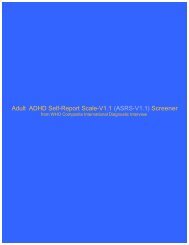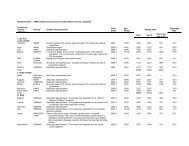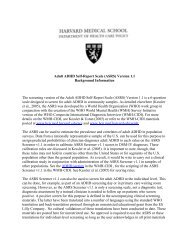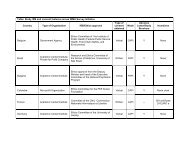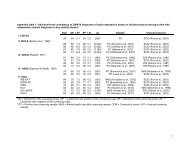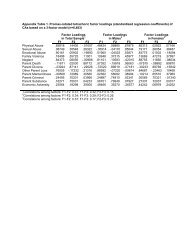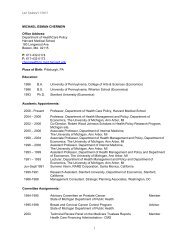Model Quality Report in Business Statistics - Harvard ...
Model Quality Report in Business Statistics - Harvard ...
Model Quality Report in Business Statistics - Harvard ...
You also want an ePaper? Increase the reach of your titles
YUMPU automatically turns print PDFs into web optimized ePapers that Google loves.
2.1.4.2 The Jackknife method<br />
The jackknife <strong>in</strong>volves dropp<strong>in</strong>g an observation and recalculat<strong>in</strong>g the estimates from the<br />
rema<strong>in</strong><strong>in</strong>g observations, repeat<strong>in</strong>g successively until all observations have been dropped, and<br />
then f<strong>in</strong>d<strong>in</strong>g the variance of the result<strong>in</strong>g series of estimates (with a suitable multiplier to give<br />
approximate unbiassedness). The drop-one jackknife is usually used, as it can be shown to<br />
give the variance estimate with the smallest sampl<strong>in</strong>g variability, although it is possible to<br />
drop pairs of observations (or even more) too; this strategy is usually adopted to speed up<br />
process<strong>in</strong>g s<strong>in</strong>ce drop-one is the most processor-<strong>in</strong>tensive method. We consider only dropone<br />
methods here. More <strong>in</strong>formation on the jackknife estimator is <strong>in</strong> M2.4.2.2-M2.4.2.3.<br />
It should be noted that the jackknife is only strictly applicable <strong>in</strong> with-replacement designs. It<br />
can be used <strong>in</strong> without-replacement designs where the sampl<strong>in</strong>g fractions are “sufficiently<br />
small” (Wolter 1985, p168), but <strong>in</strong> many bus<strong>in</strong>ess survey designs, the sampl<strong>in</strong>g fractions are<br />
relatively large. The dangers of this approach are illustrated <strong>in</strong> the simulation <strong>in</strong> chapter 3<br />
below.<br />
2.1.4.3 The Bootstrap method<br />
The bootstrap <strong>in</strong>volves resampl<strong>in</strong>g a number of times with replacement from the sampled<br />
observations, and calculat<strong>in</strong>g an estimate for each of the bootstrap samples. The variance of<br />
these “bootstrap” estimates is then calculated, aga<strong>in</strong> with a suitable multiplier to ensure<br />
unbiassedness. The method is described <strong>in</strong> more detail <strong>in</strong> M2.4.2.4.<br />
2.1.4.4 The Balanced Repeated Replication (BRR) method<br />
This is derived from the balanced half samples (BHS) method which has a very specific<br />
application <strong>in</strong> cluster designs where each cluster has exactly two f<strong>in</strong>al stage units. By<br />
successively delet<strong>in</strong>g one of these units and chang<strong>in</strong>g the weight of the other to compensate, a<br />
range of estimates can be produced whose variance can be calculated and suitably adjusted to<br />
give an appropriate variance estimator (Wolter 1985). Various adaptations of this can be<br />
applied <strong>in</strong> designs where the clusters have variable numbers of units, based on divid<strong>in</strong>g these<br />
<strong>in</strong>to two groups. Recent research (Rao & Shao 1996) shows that only by us<strong>in</strong>g repeated<br />
divisions (“repeatedly grouped balanced half samples” (RGBHS)) can an asymptotically<br />
correct estimator be obta<strong>in</strong>ed. This method, then, can only be used for the usual stratified<br />
designs <strong>in</strong> bus<strong>in</strong>ess surveys if we are prepared to treat a stratum as if it were a cluster, and to<br />
run the package a number of times with different divisions of the elements <strong>in</strong>to two groups;<br />
where there is an odd number of elements <strong>in</strong> the stratum the results are biassed, and ways of<br />
reduc<strong>in</strong>g this bias (but not elim<strong>in</strong>at<strong>in</strong>g it) are described <strong>in</strong> Slootbeek (1998). There are ways<br />
<strong>in</strong> which this can be done, but the results are typically unsatisfactory and the manipulation of<br />
both data and software becomes very <strong>in</strong>volved.<br />
2.1.5 Summary of requirements<br />
There is a number of requirements for po<strong>in</strong>t and variance estimation <strong>in</strong> bus<strong>in</strong>ess surveys<br />
which any software should satisfy. We have po<strong>in</strong>ted out several such requirements <strong>in</strong> the<br />
2 th<strong>in</strong>g to be estimated<br />
10



